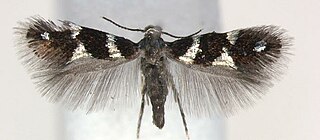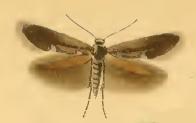
The Heliozelidae, commonly known as shield-bearer moths, are a family of small, day flying monotrysian moths distributed worldwide. The larvae of most heliozelid species are leaf miners who cut distinctive shield-shaped cases from the surface of the host leaf, hence the common name. Some species are considered pests of commercial crops such as grapevines, cranberries, and walnuts. The taxonomy of this family is poorly understood.
Heliozela argyrozona is a moth of the family Heliozelidae. It was described in the genus Antispila by Edward Meyrick in 1918 and moved to the genus Heliozela by Erik J. van Nieukerken and Henk Geertsema in 2015. It is found in South Africa.
Antispila distyliella is a moth of the family Heliozelidae. It is found on the Ryukyu Islands in Japan.
Antispila inouei is a moth of the family Heliozelidae. It was described by Kuroko in 1987. It is found in Japan.
Antispila tateshinensis is a moth of the family Heliozelidae. It was described by Kuroko in 1987. It is found in Japan.

Heliozela is genus of moths of the family Heliozelidae, described by Gottlieb August Wilhelm Herrich-Schäffer in 1853.
Heliozela autogenes is a moth of the Heliozelidae family. It was described by Edward Meyrick in 1897. It is found in Queensland.
Heliozela castaneella is a moth of the family Heliozelidae. It was described by Hiroshi Inoue in 1982. It is found in Japan.
Heliozela eucarpa is a moth of the Heliozelidae family. It was described by Edward Meyrick in 1897. It is found in New South Wales.
Heliozela sobrinella is a moth of the Heliozelidae family. It was described by Deventer in 1904 as almost identical to Heliozela praeustella but a bit larger, with a wingspan of 6 mm. It is found on Java.
Heliozela subpurpurea is a moth of the Heliozelidae family. It was described by Edward Meyrick in 1934. It is found in Japan.
Heliozela angulata is a moth of the family Heliozelidae. It was described by Lee, Hirowatari and Kuroko in 2006 and is endemic to Japan (Honshu).
Heliozela biprominens is a moth of the family Heliozelidae. It was described by Lee, Hirowatari and Kuroko in 2006 and is endemic to Japan (Honshu).
Heliozela glabrata is a moth of the family Heliozelidae. It was described by Lee, Hirowatari and Kuroko in 2006. It is found in Japan (Honshu).
Heliozela limbata is a moth of the family Heliozelidae. It was described by Lee, Hirowatari and Kuroko in 2006 and is endemic to Japan.

Gracillariinae are a subfamily of moths which was described by Henry Tibbats Stainton in 1854.
Bucculatrix serratella is a moth in the family Bucculatricidae. It was described by KShigeki Kobayashi, Toshiya Hirowatari and Hiroshi Kuroko in 2010. It is found in Japan (Honshu).
Bucculatrix hamaboella is a moth in the family Bucculatricidae. It was described by Shigeki Kobayashi, Toshiya Hirowatari and Hiroshi Kuroko in 2009. It is found in Japan (Honshu).
Bucculatrix univoca is a moth in the family Bucculatricidae. It was described by Edward Meyrick in 1918. It is found in Japan, Taiwan and India.

